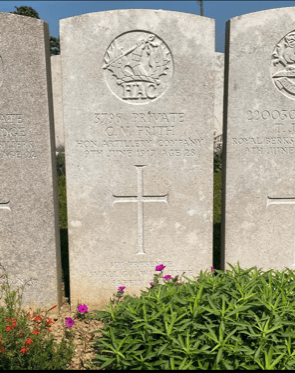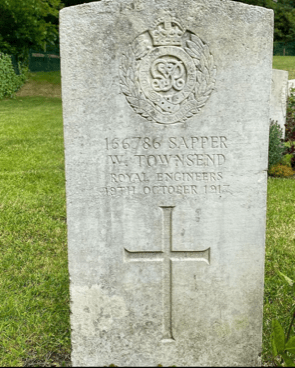In June of this year, it was a privilege to visit the graves or memorials to High Ham men on the Western Front. Photographs were taken at each location, but some seem to have been lost.

Bryson Bellot Lieut. N.S.Y
In Memory of
Lieutenant BRYSON BELLOT
1st/1st, North Somerset Yeomanry
who died age 24
on 27 March 1918
Son of Hugh H. L. Bellot, D.C.L., and Beatrice V. Bellot,
of High Ham, Somerset.
Remembered with honour
INSCRIPTION
DEEPLY LOVED SON OF HUGH H. L. & BEATRICE V. BELLOT OF HIGH HAM
Buried at ABBEVILLE COMMUNAL CEMETERY EXTENSION
Location: Somme, France
Number of casualties: 2004
Cemetery/memorial reference: I. G. 28.
Bryson Bellot was born in Adddlestone, Surrey in 1894 to Beatrice Violette Bellot nee Clarke and Hugh Hale Leigh Bellot. His brother was Hugh Hale Bellot who was born 26th January 1890

Bryson Bellot standing in front of the windmill at High Ham

Francis E Cox Pte. Glouc. Regt.
Private COX, FRANCIS E.
Service Number 202139
Died 10/10/1917
Aged 21
1st/4th Bn.
Gloucestershire Regiment
Son of George and Eliza Sophia Cox, of Berefield Cottage, High Ham, Langport, Somerset.
Commemorated at TYNE COT MEMORIAL
Location: West-Vlaanderen, Belgium
Number of casualties: 34997
Cemetery/memorial reference: Panel 72 to 75.
Guy M Crossman 2nd Lt. Welch Regt.
Second Lieutenant
CROSSMAN, GUY DANVERS MAINWARING
Died 10/07/1916
Aged 31
13th Bn.
Welsh Regiment
Son of the Rev. Charles Danvers Crossman and Isabella Jane Crossman, of High Ham, Somerset. Joined Public Schools Service Battalion 1914.
WE THANK OUR GOD UPON EVERY REMEMBRANCE OF YOU
Buried at FLATIRON COPSE CEMETERY, MAMETZ
Location: Somme, France
Number of casualties: 1152
Cemetery/memorial reference: VI. D. 3.
Guy Danvers Mainwaring Crossman was born in High Ham in 1885 to Isabelle Jane and Charles Danvers Crossman. His brother was Norman Danvers Mainwaring Crossman who was born 1882. He lived at The Rectory, High Ham.
H C (Fred) Cullen Pte. S.L.I.
Private CULLEN, HENRY CHARLES
Service Number 26023
Died 17/02/1917
Aged 39
7th Bn.
Somerset Light Infantry
Husband of Elizabeth Ann Cullen, of High Ham, Langport, Somerset.
Buried at VARENNES MILITARY CEMETERY
Location: Somme, France
Number of casualties: 1219
Cemetery/memorial reference: I. I. 4.

C Victor Frith Pte. S.L.I.
Private FRITH, CHARLES VICTOR
Service Number 3796
Died 09/06/1917
Aged 28
1st Bn.
Honourable Artillery Company
Son of Samuel Stuckey Frith and Mary Frith, of Easton, Wells, Somerset.
Buried at DUISANS BRITISH CEMETERY, ETRUN
Location: Pas de Calais, France
Number of casualties: 3289
Cemetery/memorial reference: IV. J. 6.
Charles Victor Frith was born in Wells, Somerset, United Kingdom in 1888 to Mary and Samuel Stuckey Frith. His siblings were Emily M Frith born in 1869, Alfred George Frith born in 1870, Alice J Frith born in 1871, Edward R Frith born in 1874, Sarah Frith born in 1876, Harold Frith born in 1878, Athel Frith born in 1879, James Roy S Frith born in 1882, Eleana Frith born in 1885. They lived at the family home at Coxley Mill, Wells, Somerset.
In 1911 he lived at 19 Grosvenor Place, Cheltenham, Gloucestershire. In 1915 he lived at The Cottage, High Ham, Somerset
Percy T Garland Trpr. D.G.
Private
GARLAND, PERCY
Service Number 101479
Died 24/03/1918
3rd Dragoon Guards (Prince of Wales’ Own)
Commemorated at POZIERES MEMORIAL
Location: Somme, France
Number of casualties: 14708
Cemetery/memorial reference: Panel 1 and 2.
Percy Garland was born in High Ham in 1888.

Maurice Lloyd Gnr. R.G.A.
Gunner LLOYD, MAURICE
Service Number 129655
Died 13/05/1917
Aged 19
3rd Army Pool
Royal Garrison Artillery
Son of Joseph and Emma Jane Lloyd, of Fir Tree Farm, Low Ham, Langport, Somerset.
Buried at FEUCHY BRITISH CEMETERY
Location: Pas de Calais, France
Number of casualties: 211
Cemetery/memorial reference: II. B. 6.
Maurice Lloyd was born in Henley in 1898 to Joseph and Emma Jane Lloyd. His brothers were Joe V Lloyd born in 1896, Norman Lloyd born in 1901, and George Wallis Lloyd born in 1897. In 1911, he lived at Fir Tree Farm, Low Ham.
James R U Mead Corpl. W.S.Y.
Lance Corporal MEAD, JAMES ROBERT UTTERMARE
Service Number 27724
Died 05/08/1917
Aged 26
7th Bn.
Somerset Light Infantry
Son of Robert Uttermare Mead and Florence Martha Rose Mead, of “Inglenook,” Low Ham, Langport, Somerset. Six years service; also served at Gallipoli with the West Somerset Yeomanry.
Commemorated at YPRES (MENIN GATE) MEMORIAL
Location: West-Vlaanderen, Belgium
Number of casualties: 54612
Cemetery/memorial reference: Panel 21.
James Robert Uttermare Mead was born in Low Ham in 1891 to Florence Martha Rose and Robert Uttermare Mead.

T Champion D Mead Gnr. R.H.A.
Gunner MEAD, THOMAS CHAMPION DENHAM
Service Number 176964
Died 29/07/1917
Aged 24
“X” Bty. 17th Bde.
Royal Horse Artillery
Son of Robert Uttermare Mead and Florence Martha Rose Mead, of “Inglenook,” Low Ham, Langport, Somerset.
INSCRIPTION BELOVED SON OF ROBERT AND ROSE MEAD INGLENOOK, LOW HAM SOMERSET
Buried at MAROC BRITISH CEMETERY, GRENAY
Location: Pas de Calais, France
Number of casualties: 1124
Cemetery/memorial reference: II. H. 15.
Thomas Champion Denham Mead was born in Low Ham in 1894 to Florence Martha Rose and Robert Uttermare Mead.
Albert E J G Open L.Cpl. S.L.I.
Private OPEN, A E J G
Service Number 32270
Died 02/09/1918
12th (West Somerset Yeomanry) Bn.
Somerset Light Infantry
Buried at PERONNE COMMUNAL CEMETERY EXTENSION
Location: Somme, France
Number of casualties: 1424
Cemetery/memorial reference: III. D. 34.
Albert Edward Joseph George Open was born in Isle Brewers, Somerset in 1895.

E Charles Rood Ptr. Can. Infy.
Private
ROOD, ERNEST CHARLES
Service Number 186322
Died 03/05/1917
Aged 24
27th Bn.
Canadian Infantry
Son of George and Elizabeth Ann Rood, of Henley, High Ham, Langport, Somerset, England.
Commemorated at VIMY MEMORIAL
Location: Pas de Calais, France
Number of casualties: 11242
Ernest Charles Rood was born in High Ham on 24th December 1892 to Elizabeth Ann and George Rood. His siblings were Albion Rood born in 1891, Hubert Rood born in 1897, Edith Rood born in 1900, and Lucy Ann Rood born in 1904. In 1911 they lived at Henley Corner, High Ham.

Walter H Townsend Pte. R.E.
Sapper TOWNSEND, WALTER
Service Number 166786
Died 19/10/1917
Aged 20
233rd Field Coy.
Royal Engineers
Youngest son of the late John and Clara Townsend, of King St., Swindon. Carpenter and Wheelwright.
Buried at Coxyde Military Cemetery
Walter Townsend was born in Swindon, Wiltshire in 1897.

Augustus Wilkins Pte. Can. Infy.
Private WILKINS, A
Service Number 255104
Died 02/09/1918
Aged 26
46th Bn.
Canadian Infantry
Son of William Dewdney Wilkins and Sarah Wilkins, of White House Farm, Henley, High Ham, Langport, Somerset, England.
Buried at DURY CRUCIFIX CEMETERY
Location: Pas de Calais, France
Number of casualties: 292
Cemetery/memorial reference: III. C. 22.
Augustus Wilkins was born in High Ham in 1894.










